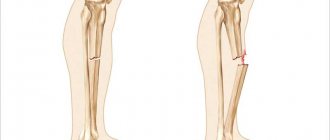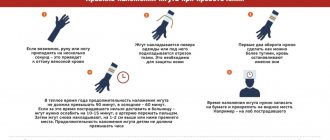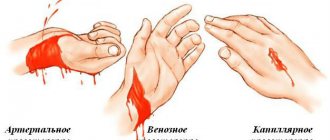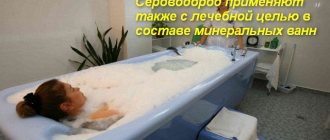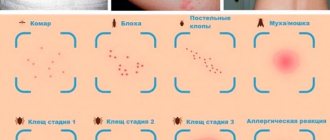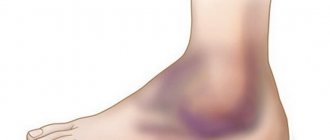First aid for a closed fracture
When providing first aid for a closed fracture, you should immediately contact an ambulance. After this, it is necessary to immobilize the broken limb and, if possible, apply ice or a cold object to the injury site. The person may be given a painkiller. When transporting independently, a splint is applied using available items: board, stick, ski, etc.
In the absence of available means, the injured limb is bandaged to the uninjured one. During transportation, the victim must lie down - the broken limb should be slightly raised.
First aid and diagnostics
First of all, the damaged part must be immobilized, i.e. immobilize, ensuring complete rest. To do this, use medical splints and other devices, for example, improvised means (sticks, cardboard).
If a hip or shoulder bone is broken, a splint is applied, covering 3 joints at once. In other cases, it is enough to cover 2 adjacent joints - before and after the fracture site and bandage it securely. If there are bone fragments, under no circumstances should you pull them out yourself. It is also necessary to disinfect the wound to prevent infection of the skin and blood.
To diagnose, you need to seek emergency help as quickly as possible or visit a doctor - therapist, surgeon, or orthopedist. The specialist conducts an external examination and identifies complaints. The patient also undergoes an x-ray to confirm the diagnosis. The picture can be taken in 1 or 2 projections.
First aid for an open fracture
Such an injury is extremely dangerous, as the wound can become infected. First aid for an open fracture begins with stopping bleeding using a pressure bandage or tourniquet if significant blood loss is observed. Antiseptic preparations are used to treat the skin around the wound. To transport the victim, it is necessary to carefully apply a splint without touching the wound.
Causes
Depending on the cause of occurrence, traumatic and pathological fractures are distinguished. The cause of traumatic bone fractures is a sharp, sudden action of a mechanical shock force on the bone. Pathological fractures appear when a certain pathological process affects bone tissue. This may be the result of a cyst or the development of a malignant tumor. In this case, the structure of the bone tissue is gradually destroyed and even small loads can lead to a fracture. With the second type, the risk of fracture increases several times. It even gets to the point where a person can also break a leg while walking. Here the reason is that this is a pathology of the bone itself, and not an external influence on it.
Types of fractures
Broken arm
First aid for arm fractures is based on prompt immobilization of the limb, application of a splint and fixation. Severe pain is relieved with painkillers. If pain shock begins to develop, the victim is warmed up and given hot tea. It should be noted that drinking is prohibited if the patient is vomiting or has an abdominal injury. When the symptoms of shock are eliminated, the injured person can be moved.
An open fracture of the arm requires stopping the bleeding using a tourniquet, which is applied above the injury. Antiseptics are used to treat the wound. Having stopped the bleeding and treated the wound, it is necessary to carry out the procedure of fixing the hand.
Attempts to realign bones are strictly prohibited.
Broken leg
First aid for leg fractures involves using a splint to secure the limb. An open injury may bleed, so stop the bleeding using a tourniquet. The wound is treated with antiseptics, and if the victim feels severe pain, anesthetics are used.
Independent attempts to straighten the bone are strictly prohibited.
Spinal fracture
A spinal fracture is a serious injury that threatens the life of the victim. For such a fracture, pain relief must be given very quickly, and the body must be fixed immediately. To move a person, boards, doors, and plywood are used. The head is fixed with a rigid collar made of suitable items.
It is prohibited to sit down, try to stand, pull the limbs, or straighten the spinal column of the victim.
Pelvic fracture
A pelvic fracture can be accompanied by severe complications and internal bleeding, which sometimes result in disability and death. When providing first aid in such cases, you should examine the victim, immobilize him in a supine position (knees should be bent), fix the pelvis, and raise the knees with a roller. In addition, the patient’s condition should be constantly monitored until doctors arrive.
It is forbidden to seat or try to position a patient.
Fractured ribs
When a rib is fractured, internal organs and the cardiovascular system can be damaged, which is very dangerous for the victim. However, a simple fracture of one or two ribs does not require the attention of specialists - the patient recovers on his own. In difficult cases, it is necessary to urgently hospitalize the injured person and provide him with qualified assistance.
This type of fracture requires rest, so it is worth limiting active movements and sports.
Tibia fracture
First aid for lower leg injuries consists of fixing the limb, applying a splint, and administering painkillers to the patient. If there is bleeding, a tourniquet is applied.
Repositioning the bone is strictly prohibited.
Shoulder fracture
A shoulder injury can be complicated by internal hemorrhage, which is extremely dangerous to health. The patient needs immobilization for a fracture using a splint, and he should also be given painkillers. The victim must be moved in a sitting position.
It is forbidden to straighten the shoulder and carry the patient without fixing the limb.
How to distinguish a fracture from a dislocation
A fracture is a break in the integrity of the bone, while a dislocation is a rupture of the joint capsule and ligaments. This can lead, for example, to sprains. In this case, movements are completely blocked. At the same time, during a fracture, the damaged bones are quite mobile and therefore require immediate immobilization.
If a dislocation occurs, severe pain is felt in the joint, it swells, and a change in shape and unevenness of the surface are visually noticeable. Moreover, during a dislocation, the length of the limb and its shape never change, but the joints themselves are displaced. If a fracture occurs, the length of the bone, on the contrary, may change.
Bruise - what is it?
A bruise is an injury in which there is no disruption of the integrity and structure of the tissue. With a bruise, there is no large open wound or heavy bleeding; only abrasions are possible, which quickly disappear. But bruising is quite likely. It is caused by internal hemorrhage: tissues compressed during a bruise are pressed against the bones, damaging blood vessels and the latter bursting. The result is a blue-purple spot that turns yellow-green over time.
Another sign is swelling that forms at the site of the bruise, which limits movement in the damaged organ.
And of course, the main manifestation of a bruise is pain - varying in intensity, from mild to severe.
Treatment
The main objectives of treating a victim with a fracture are saving his life and preserving the limb, restoring the integrity of the bone and the anatomical shape of the joint, the function of the damaged limb and the working capacity of the victim. First aid is aimed at preventing displacement of bone fragments, damage to soft tissues, wound infection, the development of traumatic shock and massive blood loss. Necessary actions: immobilize the damaged area of the skeleton using a splint that captures the joints above and below the site of injury. Stop the bleeding with a tourniquet and apply a sterile bandage to the wound. Give an anesthetic: analgin or promedol. Transport the victim to the emergency room. In case of multiple fractures and spinal injuries, it is not recommended to move the patient until the ambulance arrives. Conservative treatment consists of immobilization and the use of plaster casts after closed reduction of the fracture or without it (if there is no displacement). When applying plaster, the limb must be in the physiologically correct position. Its distal parts (for example, fingers in case of a fractured limb) must be open to be able to determine swelling and prevent disruption of tissue trophism. Sometimes traction is necessary for a fracture—the use of skeletal, cuff, adhesive, or adhesive traction. This method helps to neutralize the action of muscle layers that are attached to bone fragments, prevent their displacement and create conditions for bone tissue regeneration. Skeletal traction gives the greatest effect. A weight attached to a wire that is passed through the bone ensures that the bone fragments are maintained in a position that is optimal for tissue restoration. The disadvantage is the forced immobilization of the patient, leading to a deterioration in his general condition. For cracks in long bones and fractures of small bones, functional methods are used. They involve the absence of immobilization or minimal immobilization of the damaged area and are reduced to providing it with rest. Surgical treatment is necessary for jaw fractures (installation of an external fixation device), restoration of spongy bones (cranial vault), excessive formation of callus, etc. In the postoperative period, the fracture site is immobilized. Recovery time ranges from several weeks to several months. If bone restoration does not occur and a false joint is formed (persistent abnormal mobility at the fracture site), endoprosthetics methods are used (replacement of elements of the musculoskeletal system with implants). After the cast is removed, rehabilitation therapy begins. This is, first of all, a massage. Prescribed 10-45 days after the fracture. It accelerates the process of callus formation, improves blood circulation and tissue nutrition, and prevents muscle atrophy. CRM therapy is a passive development of joints (without the participation of muscles) using a specially tuned mechanical device. Physiotherapy. In the first 10 days, exercises are done for intact joints and limbs. They prevent muscle weakness and joint stiffness. After removing the cast, exercise therapy helps restore the mobility of damaged joints and muscle strength. It is recommended to increase the load gradually, completing rehabilitation with active gymnastics, which helps neutralize the consequences of the fracture.
Factors affecting fracture healing
Common factors include: dysfunction of the endocrine glands, pregnancy, vitamin deficiency, acute and chronic infectious diseases, trophic disorders, etc.
Local factors are the leading causes of impaired reparative osteogenesis. They can be divided into three groups (D. V. Ruda, 1976):
1. Errors in treatment: insufficient reposition of fragments and unresolved interpositions of soft tissues between them, unreliable immobilization after reposition and frequent replacement of plaster casts, too extensive bone skeletonization during surgery (blood supply is disrupted), use of inadequate fixators for osteosynthesis (unstable fixation), etc. .
2. Factors associated with the severity of the injury and its complications: multiple and open fractures, massive damage to soft tissues (muscles, blood vessels, nerves), suppuration and osteomyelitis.
3. Reasons that depend on the anatomical and physiological characteristics of the fracture: location, degree of blood supply (fracture of the head or neck of the femur, scaphoid) and others.
Violation of reparative osteogenesis in bone fractures leads to delayed consolidation (fusion) of fragments, nonunion or formation of a false joint (pseudoarthrosis), and sometimes to neoarthrosis (new joint). Delayed consolidation of a fracture refers to cases where bone fusion of fragments has not occurred within the generally accepted normal time frame for a specific location of the fracture.

